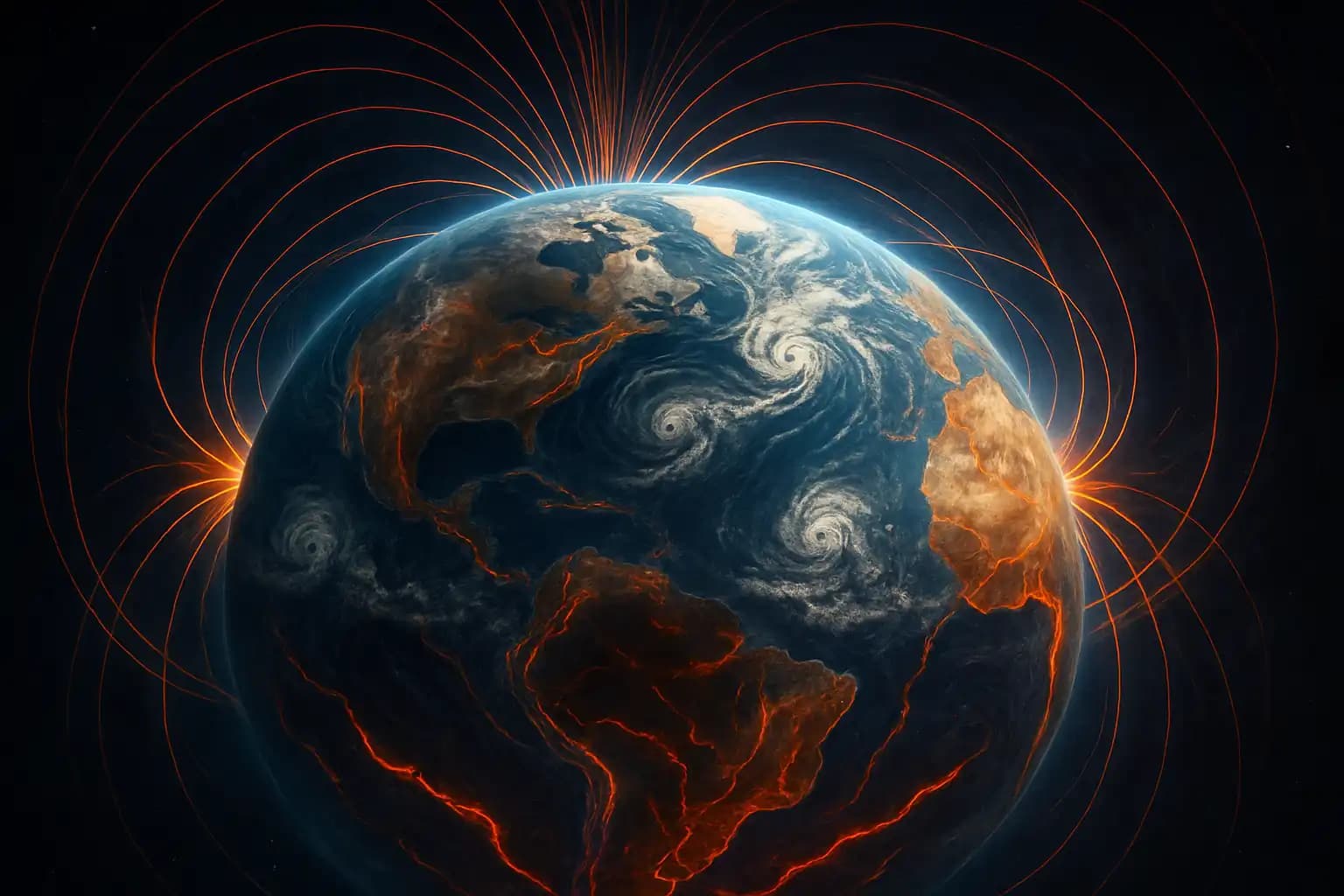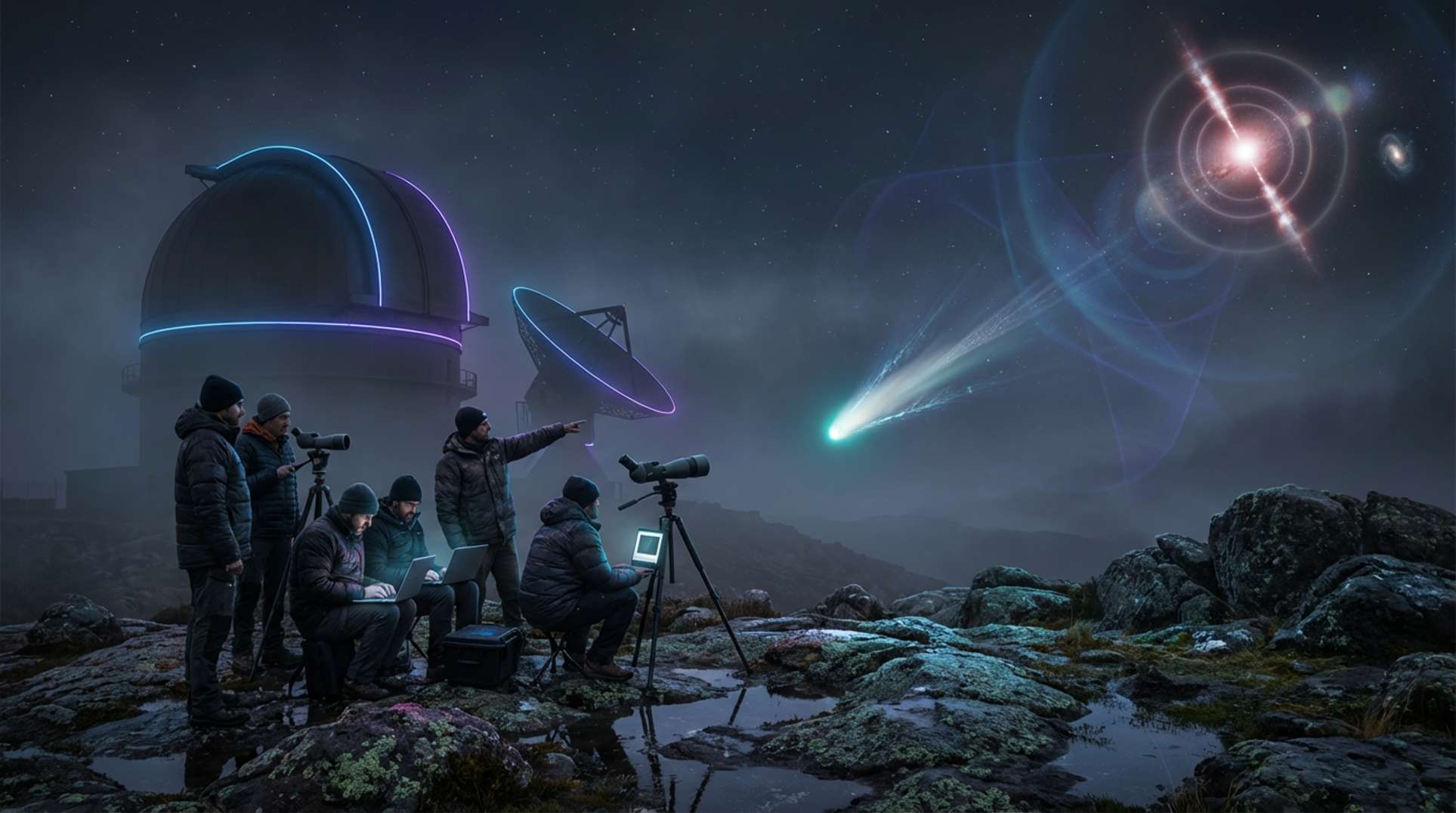It starts with a feeling—an almost subliminal tension when the wind hushes or a subway platform vibrates harder than usual. This sensation travels faster than any official alert, cutting through routine and pushing the mind toward one intrusive question: what is happening to Earth? In living rooms, social feeds, and lab meetings, that unease has crystalized into the same suspicion Bright Side’s viral animation highlights: the ground trembles, the air thickens, and something enormous may be moving beneath our feet.
Over the last year, the planet’s warning lights have flashed in disconcerting unison. Satellites over the South Atlantic reboot without explanation, Schumann resonance charts spike off baseline, and Yellowstone’s caldera inches upward as if taking a deep breath. Individually, each anomaly sits within statistical possibility. Together, they read like scattered pages of an apocalyptic screenplay—one we might be sleepwalking into.
Magnetic Weak Spots and the Expanding South Atlantic Anomaly
Ask spacecraft engineers what keeps them awake, and they won’t cite rogue asteroids; they will point to a patch of weak magnetism from Brazil to Namibia. Known as the South Atlantic Anomaly, this region funnels high-energy particles closer to Earth’s surface, zapping satellite electronics and occasionally scrubbing hard drives clean. Earlier this year, a NASA visualization mapped how the dent is widening and splitting in two—a trend illustrated on NASA’s 2015-2025 geomagnetic model. The top-ranked Brave result warns that newer satellites already budget double for radiation shielding.
Ground stations track every glitch, while independent researchers amplify them on forums, often linking to the deeper context in this investigative dispatch. The article suggests the anomaly’s acceleration could dovetail with a broader polar-shift scenario, a concern echoed by geophysicists parsing core-field simulations. While no one claims the dent predicts an imminent flip, history shows that magnetic excursions correlate with increases in cosmic-ray exposure and, by extension, mutation rates—bad news for everything from astronauts to microchips.
Earth’s Pulse: Unprecedented Schumann Resonance Spikes
If the magnetic field is Earth’s shield, then the Schumann resonance acts as its heartbeat—an extremely low-frequency signal generated between the ground and ionosphere. In May, global monitoring networks recorded a surge so high that instruments clipped for the first time since digital logging began. The phenomenon quickly trended online, drawing millions to the peer-reviewed study topping Brave’s search returns, hosted by Wiley at this location. Researchers blamed a combination of record lightning, solar wind compression, and ionospheric heating, yet they admitted the amplitude still defied expectations.
The data aligns uneasily with eyewitness reports of pressure headaches and insomnia, prompting some to seek esoteric explanations. More grounded commentators note that strong ELF disturbances can interfere with submarine communications and even affect power-grid harmonics. A June brief on that risk is archived at this link, where grid operators warn that sustained resonance spikes could act like a slow-motion EMP for unshielded infrastructure.
Yellowstone Uplift and the Supervolcano Question
While the sky flickers, the ground swells. GPS arrays inside Yellowstone National Park reveal a clear uplift measured in centimeters per year. Newsweek’s scoop on a magma intrusion at this report brings academic caution into mainstream glare. Volcanologists emphasize that uplift cycles have come and gone without catastrophe, yet they concede that the current deformation aligns with increased thermal unrest at Norris Geyser Basin.
Outside the peer-review echo chamber, the creeping bulge inflames doomsayers who track every microscopic quake in the region, cross-referencing them with prophecy chatter and underground supply-chain movements. Much of that speculation traces back to raw seismographs circulating on forums like the one dissected at this geological deep dive. Government agencies maintain that no eruption looms, but residents within the ash-fall zone quietly refresh contingency checklists.
Climate Volatility: From Flash Droughts to Hyper-Cyclones
Atmospheric models once treated 1-in-1,000-year storms as statistical outliers; now they schedule them annually. Meteorologists blame a warped jet stream that funnels arctic blasts into Texas and Saharan heat into Spain. New research ties the wobble to polar amplification and a warm Atlantic, though some analysts also consider aerosol declines from pandemic-era shutdowns.
Insurance actuaries crunch numbers in real time, poring over reanalysis packages and comparing them with field observations such as drone-filmed water shortages at this regional report. The conclusion is stark: if hydrological extremes continue, global breadbaskets could swing between flood and drought, destabilizing grain futures and political regimes.
The specter of agricultural failure feeds a wider conversation about the sixth mass extinction, a topic explored thoroughly on Wikipedia’s Holocene extinction page. Biologists warn that cascading species loss erodes ecosystems and removes buffers that once dampened weather extremes—another loop tightening humanity’s margin for error.
Celestial Wildcards: Space Debris, Sunspots and Interstellar Intruders
Even as we focus on the soil and sky, space remains noisy. Astronomers last year spotted an object with a gravity-defying trajectory, igniting debates that spilled into op-eds and, eventually, Lawrence-Livermore risk memos. The discovery next traveled through the investigative node at this link, which lays out competing theories—comet, probe, or something in between.
Meanwhile, solar physicists upgrade flare forecasts as the current sunspot cycle surges beyond predictions. A Carrington-class event would clip satellites already suffering from radiation dents and could fry enough transformers to plunge continents into darkness. The U.S. grid’s vulnerability remains the subtext of congressional hearings that often cite the worst-case scenario matrix published at this power-grid analysis.
Psychology of Impending Doom: From Doomscroll to Decision
Data overload warps the collective psyche. Neuroscientists observe heightened cortisol in subjects reading push notifications about simultaneous crises. That stress feeds a doomscroll habit, which algorithms reward with more anxiety-inducing headlines. The loop intensifies when ancient scripture or classic cult films mirror modern sensor readouts, as illustrated in this cultural commentary.
Behavioral economists note that perpetual alarm short-circuits long-term planning. People either freeze or migrate into magical thinking, leaving infrastructure upgrades starved for public support. Breaking that paralysis demands credible, actionable information free from sensational filters—a service increasingly provided by independent repositories like Unexplained.co, which hosts raw data sets alongside expert annotations without autoplay adrenaline loops.
Precarious Resilience: Are We Ready for the Cascades?
Resilience strategies exist but remain patchy. Nordic utilities bury power lines to thwart geomagnetic-induced currents; coastal cities raise sea walls for two-meter surges; and agricultural hubs experiment with drought-resistant seed vaults. Yet many fixes operate in isolation, lacking the interconnected robustness needed when multiple hazards strike at once.
Consider a hypothetical chain reaction that begins with a solar flare hitting just as the South Atlantic Anomaly’s twin lobes douse satellites in additional radiation. Damaged GPS streams nudge flight paths off course, while blackout-plagued server farms throttle financial trades. Simultaneously, a Yellowstone tremor triggers precautionary evacuations, clogging highways and complicating grid repair crews’ logistics. Add a tropical cyclone driven by a warped jet stream, and the patchwork fails.
Experts stress that systems theory, not siloed risk management, must guide preparedness. They advocate for distributed micro-grids, redundant storage, and international disaster blockchain ledgers—concepts still on whiteboards but inching closer to pilot projects. Whether these ideas materialize before the next shock arrives will determine if humanity writes a comeback story or a cautionary tale.
Conclusion: Listening to Earth’s Multilayered Alarm System
The tremors, spikes, and bulges recorded this year are not isolated oddities; they are overlapping alarms from Earth’s crust, oceans, atmosphere, and magnetic shell. Interpreting them calls for a holistic lens, blending satellite telemetry with folklore, seismology with solar physics, and policy with behavioral science. The resulting mosaic may unsettle, but denial promises a harsher fate.
Bright Side’s animation asked whether we are ready for what’s coming. Readouts from magnetometers, resonance charts, and uplift sensors imply the test may arrive sooner than planners hope. Yet readiness is less about prophecy and more about practice: informed citizens, transparent data, and collaborative engineering stand between a world that merely survives and one that thrives. Earth clears its throat; the audience can decide whether to panic, prepare—or do both, but in the right proportions.




